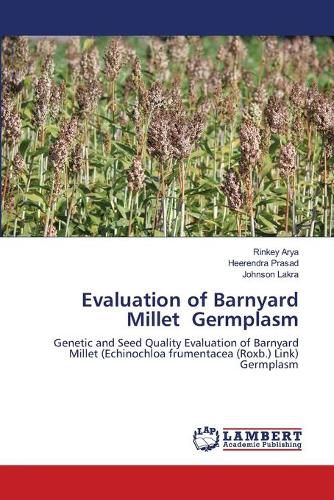Readings Newsletter
Become a Readings Member to make your shopping experience even easier.
Sign in or sign up for free!
You’re not far away from qualifying for FREE standard shipping within Australia
You’ve qualified for FREE standard shipping within Australia
The cart is loading…






This title is printed to order. This book may have been self-published. If so, we cannot guarantee the quality of the content. In the main most books will have gone through the editing process however some may not. We therefore suggest that you be aware of this before ordering this book. If in doubt check either the author or publisher’s details as we are unable to accept any returns unless they are faulty. Please contact us if you have any questions.
Barnyard millet (Echinochloa frumentacea (Roxb.) Link) also called as Jhangora, Sawan or Madira is largely a self-pollinated crop, tall erect up to 60 to 120 cm in height, the stem as well as leaves being green in colour. Barnyard millet is mainly grown in India, China, Japan, and Korea for human consumption as well as fodder. The crop is valued for its drought tolerance, short growth period, and superior nutrition value. In India, the crop is grown in Madhya Pradesh, Uttarakhand, Tamil Nadu, Andhra Pradesh, Karnataka, Maharashtra and Bihar. Barnyard millet has emerged as very important dual purpose feed and fodder crop. The grain can be consumed as whole grain or ground into flour which is used for porridge and various flat cakes or chapatis. Thus small millets are nutritionally rich staple food crop. But besides that they also provide good quality stover which is important for hill farming system, where fodder has become scarce in recent years. In fact the stover of barnyard millet is one of the best in terms of nutritional quality among all the existing stovers.
$9.00 standard shipping within Australia
FREE standard shipping within Australia for orders over $100.00
Express & International shipping calculated at checkout
This title is printed to order. This book may have been self-published. If so, we cannot guarantee the quality of the content. In the main most books will have gone through the editing process however some may not. We therefore suggest that you be aware of this before ordering this book. If in doubt check either the author or publisher’s details as we are unable to accept any returns unless they are faulty. Please contact us if you have any questions.
Barnyard millet (Echinochloa frumentacea (Roxb.) Link) also called as Jhangora, Sawan or Madira is largely a self-pollinated crop, tall erect up to 60 to 120 cm in height, the stem as well as leaves being green in colour. Barnyard millet is mainly grown in India, China, Japan, and Korea for human consumption as well as fodder. The crop is valued for its drought tolerance, short growth period, and superior nutrition value. In India, the crop is grown in Madhya Pradesh, Uttarakhand, Tamil Nadu, Andhra Pradesh, Karnataka, Maharashtra and Bihar. Barnyard millet has emerged as very important dual purpose feed and fodder crop. The grain can be consumed as whole grain or ground into flour which is used for porridge and various flat cakes or chapatis. Thus small millets are nutritionally rich staple food crop. But besides that they also provide good quality stover which is important for hill farming system, where fodder has become scarce in recent years. In fact the stover of barnyard millet is one of the best in terms of nutritional quality among all the existing stovers.